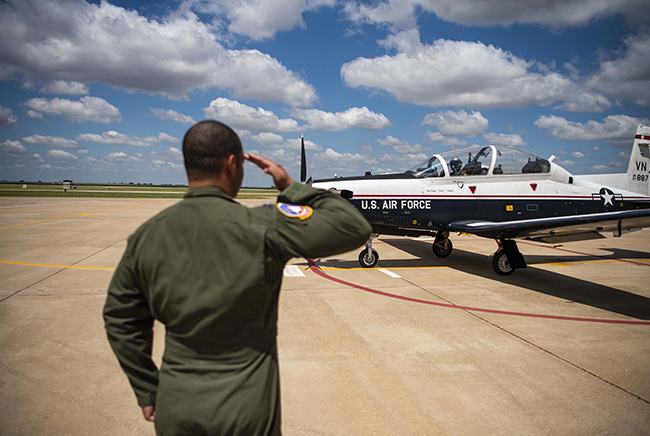
Capt. Marcel Trott, a flight commander, salutes 2nd Lt. Corey Persons, a student pilot assigned to Specialized Undergraduate Pilot Training Class 20-09, before his solo flight in the T-6A Texan II at Vance AFB, Okla., on July 15, 2019. Air Force photo by SrA. Taylor Crul.
VANCE AFB, Okla.—The Air Force’s pilot shortage has forced its training bases to get creative to rapidly increase the number of trainees without a matching boost in funding.
At its peak, the Air Force was short 2,000 pilots, prompting a series of steps that began in 2016 to grow pilot retention and push more trained aviators through Air Education and Training Command bases.
The 71st Flying Training Wing here must ramp up production from 325 new pilots last year to 400 this year, then grow to 425 pilots in 2020. Vance is trying to do so with the same airspace, the same number of instructors, and the same number of aircraft.
To accomplish that, Wing Commander Col. Corey Simmons told Air Force Magazine that Vance is trying new ways of funneling data to airmen faster as well as changing how they practice flying.
“The first thing we had to do is look at our own house and make sure we had everything in place to be able to create as many sorties, as many instructor opportunities, as many of those things as we can,” Simmons said.
All AETC pilot training bases reviewed training syllabi to remove redundancies and let pilots accelerate their training process if they prove capable. For example, pilots may not need to complete all 11 test flights to receive their wings if they show proficiency earlier. But the quality of training remains the same.
“We are being as efficient as we can with our resources, and our standard of what a pilot is hasn’t changed,” Simmons said. “The standard is still the same to be able to walk across the graduation line.”
Vance uses squadron innovation funds and authorities from the Air Force to find new ways to present information to trainees. Each student pilot gets an iPad to access video-recorded courses, as well as a simulation that walks through flight checklists.
“If we’re giving them things to read three months from now, why can’t they have it now” Simmons said. Giving the pilots lessons earlier and turning to smaller simulations offers students greater understanding before they reach full-scale simulators and actual aircraft.
Vance has also implemented desktop computer- and virtual-reality-based simulations in line with the Pilot Training Next initiative. Multiple rooms at the base have dozens of PCs and VR headsets so pilots can come in to practice flying. Available systems that let people go through basic flight motions include HTC Vive headsets, throttle and control sticks, and Google Earth-based software that shows the area around Vance.
Older pilot training relied on the “read it, regurgitate it” method. But a new emphasis on tablets and VR lets pilots “touch it and do it” to the point where they may not need as much time in a simulator or an aircraft to vet their knowledge, Simmons said.
The increase in pilot training requirements at Vance came amid challenges for the whole AETC training fleet. In early 2018, AETC grounded T-6 Texan II flights after pilots experienced hypoxia-like symptoms in the air. The Air Force identified an issue with the on-board oxygen generation system and plans to fix the problem, though it will take much of next year to update the fleet.
In the meantime, pilots were shown how to identify possible physiological incidents and how to immediately land an aircraft. Simmons said his wing is confident in the fix and is taking on “the right level of risk.” OBOGS-related events now happen less often than before the grounding, but Simmons says remedying the problem is still a big deal.
